cadence信号完整性仿真步骤
- 格式:pdf
- 大小:2.41 MB
- 文档页数:7

信号完整性仿真流程
信号完整性仿真是一种通过计算机辅助工程(CAE)软件模拟电子系统中信号质量的过程,主要关注的是高速数字信号在传输过程中受到的各种干扰对信号质量的影响。
简要流程如下:
1. 模型建立:根据设计需求,创建电路板、连接器、电缆等模型,并定义元器件参数及互连结构。
2. 设置边界条件:设定电源网络、信号激励(如上升沿、下降沿、数据眼图等)、负载条件等边界条件。
3. 选择仿真类型:进行瞬态仿真分析信号时域行为,如延时、振铃、过冲等;进行频域仿真分析信号频谱特性,如插入损耗、串扰、反射系数等。
4. 执行仿真:运行仿真软件,计算并输出仿真结果,如眼图、时序图、S参数等。
5. 结果分析:解读仿真结果,评估信号完整性是否满足设计要求,如是否满足建立保持时间、是否存在严重的噪声干扰或信号衰减等。
6. 优化设计:根据仿真结果对设计方案进行优化调整,如调整布线拓扑、添加端接电阻、优化电源/地平面布局等,然后再进行仿真验证,直至满足信号完整性要求。
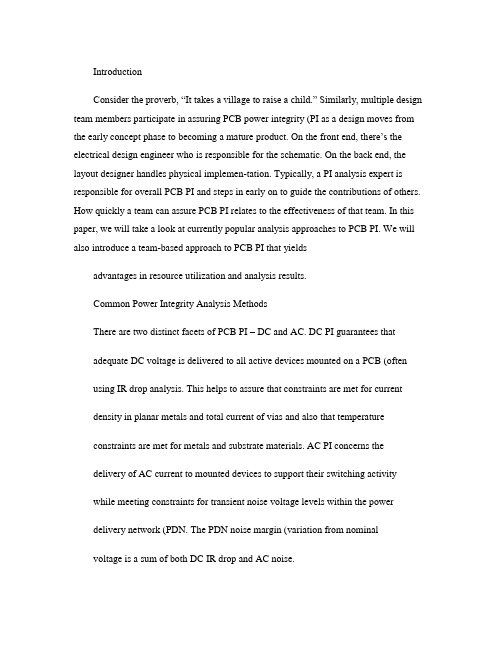
IntroductionConsider the proverb, “It takes a village to raise a child.” Similarly, multiple design team members participate in assuring PCB power integrity (PI as a design moves from the early concept phase to becoming a mature product. On the front end, there’s the electrical design engineer who is responsible for the schematic. On the back end, the layout designer handles physical implemen-tation. Typically, a PI analysis expert is responsible for overall PCB PI and steps in early on to guide the contributions of others. How quickly a team can assure PCB PI relates to the effectiveness of that team. In this paper, we will take a look at currently popular analysis approaches to PCB PI. We will also introduce a team-based approach to PCB PI that yieldsadvantages in resource utilization and analysis results.Common Power Integrity Analysis MethodsThere are two distinct facets of PCB PI – DC and AC. DC PI guarantees thatadequate DC voltage is delivered to all active devices mounted on a PCB (oftenusing IR drop analysis. This helps to assure that constraints are met for currentdensity in planar metals and total current of vias and also that temperatureconstraints are met for metals and substrate materials. AC PI concerns thedelivery of AC current to mounted devices to support their switching activitywhile meeting constraints for transient noise voltage levels within the powerdelivery network (PDN. The PDN noise margin (variation from nominalvoltage is a sum of both DC IR drop and AC noise.DC PI is governed by resistance of the metals and the current pulled from thePDN by each mounted device. Engineers have, for many years, applied resistivenetwork models for approximate DC PI analysis. Now that computer speedsare faster and larger addressable memory is available, the industry is seeingmuch more application of layout-driven detailed numerical analysis techniquesfor DC PI. Approximation occurs less, accuracy is higher, and automation ofHow a Team-Based Approach to PCB Power Integrity Analysis Yields Better ResultsBy Brad Brim, Sr. Staff Product Engineer, Cadence Design SystemsAssuring power integrity of a PCB requires the contributions of multiple design team members. Traditionally, such an effort has involved a time-consuming process for a back-end-focused expert at the front end of a design. This paper examines a collaborative team-based approach that makes more efficient use of resources and provides more impact at critical points in the design process.ContentsIntroduction . (1)Common Power IntegrityAnalysis Methods . (1)Applying a Team-Based Approachto Power Integrity Analysis . (3)Summary (6)For Further Information . (7)whole-design analysis and postprocessing results are commonly available commercially. In fact, DC PI analysis for PCB designs has become a “signoff” requirement for many OEMs. See Figure 1 (left for typical results for current density.Since metal conductivity is temperature-dependent, DC IR drop is a nonlinear analysis. IR drop results can vary by more than 20% when temperature effects are considered, according to case studies for high-power designs. There is, however, a way to accurately characterize PCB IR drop wh ile assuring that the PDN noise margin isn’twasted. Using a DC analysis tool that provides capabilities such as electrical/thermal co-simulation, perform a linear electrical analysis at ambient temperature; take the resulting power loss and apply it to perform a linear thermal analysis. Then, perform another linear electrical analysis with consideration of the localized temperature-dependent conductivity. This process converges in just a few iterations to yield a desired result. See Figure 1 for an illustration of this solution, as implemented in the Cadence® Sigrity™ PowerDC™DC analysis tool.TemperatureLoss DensityPlane CurrentSurface TemperatureElectrical AnalysisThermal AnalysisFigure 1: Current density (left and temperature distribution (right for a PCB design due to DC powerdelivery as two linear solutions are iteratively linked to address nonlinear electro-thermal analysis.AC PI is governed by voltage regulator modules, loop inductances, decoupling capacitors (decaps, and plane capacitance. AC PI effects tend to be global in nature dueto plane resonances, plane-to-plane coupling, and shared reference planes. As such, this calls for full-board analysis, as well as more resource-intensive analysis algorithms. A hybrid of circuit theory and electromagnetic (EM analyses is the most commonly applied AC PI analysis for PCBs. This type of analysis is available in the frequency domain to extract S-parameters, using a tool such as Cadence Sigrity PowerSI™ frequency-domain electrical analysis solution. It’s also available in the time domain to directly generate transient waveforms, using a tool such as Cadence Sigrity Speed2000™ time-domain analysis solution. With the proper tools, an engineer can, in tens of minutes, accurately characterize the PDNbehavior of even the largest and most complex PCBs from DC to multi-gigahertz using single- to low double-digit gigabytes of memory.Transient PI analysis may seem attractive because it directly yields noise waveforms; however, in reality, it is less commonly applied than frequency-domain impedance analysis. “Target impedance” profiles are applied as PIconstraints. Lower impedance corresponds to lower transient noise. Without direct vendor specification, reasonable target impedance may be estimated based on device specifications for voltage ripple and AC switching current. See Figure 2 for a comparison of frequency-domain and time-domain results. In this comparison, the Cadence Sigrity OptimizePI ™ tool was used to significantly reduce an impedance peak near 800MHz by applying an alternate set of decaps to mount for a DIMM module. This solution reduced peak-to-peak PDN noise for the optimized design by 12% and the component and manufacturing cost of the decap implementation by 21%. 2How a Team-Based Approach to PCB Power Integrity Analysis Yields Better ResultsFigure 2: Impedance profile and transient PDN noise of a DIMM before and after thedecap implementation was optimized.Applying a Team-Based Approach to Power Integrity AnalysisTraditionally, PI experts have performed pre-layout decap selections and initial IR drop analyses. This is a substantial time investment at the front end of a design for a back-end-focused expert. By applying a more collaborativeapproach, a design team can make better use of its resources and expertise, and generate more impactful results.A team could set up simple analyses that yield actionable results and that could be performed by other members of the PI team. This PCB PI team would ideally consist ofthree key members: design engineer, layout designer, and PI analysis expert, as shown in Figure 3.Design Engineer•Can start with either BOM or schematic•Apply Power Feasibility Editor for DeCapselection and PIconstraint definitionLayout Designer•Can start as early as floorplanning stage •First order analysis directly on layout•Analyze, edit, re-analyze•DeCap placement guidanceand DRCPI Analysis Expert•Can start at any stage•Leverages setup and data from rest of team•Signoff capable detailed analysis Figure 3: Roles and responsibilities of the PCB PI design team. 3How a Team-Based Approach to PCB Power Integrity Analysis Yields Better ResultsThere is now a tool available on the market that supports team-based PCB PI analysis. Cadence A llegro® Sigrity PI is the industry’s first front-to-back, constraint-based PI approach for PCB and IC package designs. This tool differs from other solutions in the way that it accesses existing analysis algorithms and how the analysis results are applied. In addition, the tool also provides PI-focused infrastructure support of non-analysis tasks. As a result, design engineers and layout designers can contribute earlierand more effectively to PCB PI. The DC and AC PI analysis capabilities described in the previous section are available in the associated Power Integrity Signoff and Optimization Option.PCB design engineers are responsible for front-end tasks. They must generate an initial Bill of Materials (BOM to set in motion cost feasibility studies and assure electrical design intent by generating circuit schematics. They typically work independently of DC PI concerns. However, to support AC PI, design engineers must add decaps and include them in the BOM and the schematic. Some device vendors provide datasheet guidance for decap selection (type and/or quantity, but many do not. Even with datasheet guidance, it is tedious for design engineers toassemble and interpret the specifications for each device, instantiate all the unique components, assure they appear logically in the schematic, etc. No mechanism has existed for physical placement guidance to be communicated for back-end application.With constraint-based design methods, engineers gain a uniform interface for design-intent information and for automating a broad class of tasks across front-to-back flows. PI [electrical] constraint sets (PI Csets have been added to save all component-level PI information. Design engineers may apply PI Csets to quickly and completely define PI design intent for all mounted components. PI Csets also automate instantiation of components and inclusion in the BOM.Refer to Figure 4 for an example of a PI Cset in Allegro Sigrity PI. PI Csets contain information for each power rail,including decap component names, quantity of each component, package type, and physical placement guidance.Figure 4: PI constraint set contents viewed from the constraint manager.PI Cset creation is automated by the tool’s Power Feasibility Editor, which providesa mechanism to enter datasheet decap selection and physical placement guidance. Figure5 shows a view of the tool’s Power Feasibility Editor. In addition to placement guidance,a PI Cset communicates to the layout designer component and power rail associ-ation for decaps, helping the designer perform more reliable placement. 4How a Team-Based Approach to PCB Power Integrity Analysis Yields Better ResultsFigure 5: Single-point analysis results in the Power Feasibility Editor.The Power Feasibility Editor also provides access to approximate and detailed pre-layout analysis for selection and placement of decaps. High-level specifications are made to generate target impedance profiles when device vendors do not provide them. An approximate PI analysis called “single-point” is provided for interactive decap selection. For more detailed pre-layout, the tool provides access to the data in the Cadence Sigrity OptimizePI tool.The engineer simply clicks a button within the Power Feasibility Editor to generate PI Csets.Figure 6: Split-screen view of layout (left and IR drop analysis results (right.Unlike design engineers, layout designers are concerned with DC PI issues. Layout designers control metal shapes and vias and these, in turn, control PI behaviors for DC IR drop and current flow. Layout designers can intuitively understand and act upon analysis results for these DC PI effects. The Allegro Sigrity PI tool provides access within the layout environment to the setup and results display for DC IR drop and current constraint analyses. DC analysis is fast, though not conducted in real time in order to enable dynamic updating of analysis results as layout updates are made. 5How a Team-Based Approach to PCB Power Integrity Analysis Yields Better ResultsHow a Team-Based Approach to PCB Power Integrity Analysis Yields Better Results The tool provides a split-screen view, as shown in Figure 6, to support a fixedview of analysis results as layout designers dynamically make updates to address IR drop or current constraint issues. The two views are synchronized for operations that affect the display, such as layer changes, zoom, and pan. Layout designers can apply this split-screen view of DC analysis results as they craft an initial layout, before the PI analysis expert gets involved. As a more effective method to communicate where PI issues exist in the design, the split-screen view can also be applied with detailed analysis results performed separately by PI analysis experts. In fact, to more quickly verify improved PI performance, the layout designer can launch the same detailed analysis performed by the PI analyst. Layout designers strongly influence AC PI success with their placement of decaps. Decaps placed close to a device generally benefit PI, but restrict routing channels due to decap mounting vias. Decaps placed too far from a device will be ineffective at providing switching current to the device and will negatively affect PI. Present design methods do not typically provide decap placement guidance, including information as simple as which device is associated with a decap. By conveying design intent, previously described PI Csets enable more effective placement of decaps by layout designers. The associated device and power rail and placement guidance are all specified in the PI Cset. A decap placement mode is implemented to support layout designers, as shown in Figure 7. Simply select a mounted component and a power rail, and then cycle through a point-and-click placement process. The selected device is highlighted and three optional visual placement guidance displays are available: device to decap distance for top layer, device to decap distance for bottom layer, and decap effective radius. The first two are defined in the PI Cset and are conceptually familiar. The decap effective radius is the maximum distance at which the decap will be maximally effective. It is a function of the stack-up and decap mounting parasitics as well as the decap value and its intrinsic parasitics. It is dynamically computed as the cursor moves due to local availability of metal shapes on the associated power and ground layers. Decap Placement Guidance Top-side Setback Distance * Decap Effective Radius Bottom-side Setback Distance Figure 7: Layout view during decap placement for device U0501 with top (yellow andbottom (blue setback distances and decap effective radius (white circle displayed To ease the setup for detailed PI analysis, design intent and analysis setup information specified by design engineers and layout designers is available to PI analysis. PI Csets serve as a convenient mechanism to communicate updated placement guidance or requirements for updates on decap selection (either type or quantity for a specific device instance or all devices to which a PI Cset is applied. Changes to PI Csets also convey information back to the design engineer and enable automated update of the schematic and BOM. Summary While current PCB PI analysis tools are continuing to serve the design community well, they are even more effective when combined with a front-to-back, constraint-based approach. Under this type of methodology, each design team member can more efficiently accomplish his or her individual tasks and communicate design intent information to colleagues for increased efficiency of the overall PCB design flow. This approach provides access to 6How a Team-Based Approach to PCB Power Integrity Analysis Yields Better Results actionable analysis results where they are most impactful. It also leverages earlier defined analysis setup information for the PI expert, and eases communication of design changes from his or her back-end role to front-end colleagues. For Further Information To learn more about Cadence Allegro Sigrity PI solution, visit:/products/sigrity/Pages/ solution.aspx Cadence Design Systems enables global electronic design innovation and plays an essential role in the creation of today’s electronics. Customers use Cadence software, hardware, IP, and expertise to design and verify to day’s mobile, cloud and connectivity applications. © 2014 Cadence Design Systems, Inc. All rights reserved. Cadence, the Cadence logo, and Allegro are registered trademarks and OptimizePI, PowerDC, PowerSI, Sigrity, and Speed2000 are trademarks of Cadence Design Systems, Inc. All others are properties of their respective holders. 1932 01/14 CY/DM/PDF。
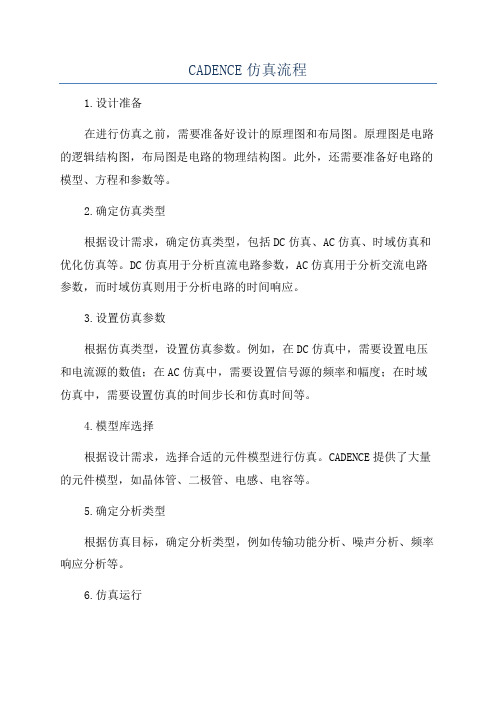
CADENCE仿真流程1.设计准备在进行仿真之前,需要准备好设计的原理图和布局图。
原理图是电路的逻辑结构图,布局图是电路的物理结构图。
此外,还需要准备好电路的模型、方程和参数等。
2.确定仿真类型根据设计需求,确定仿真类型,包括DC仿真、AC仿真、时域仿真和优化仿真等。
DC仿真用于分析直流电路参数,AC仿真用于分析交流电路参数,而时域仿真则用于分析电路的时间响应。
3.设置仿真参数根据仿真类型,设置仿真参数。
例如,在DC仿真中,需要设置电压和电流源的数值;在AC仿真中,需要设置信号源的频率和幅度;在时域仿真中,需要设置仿真的时间步长和仿真时间等。
4.模型库选择根据设计需求,选择合适的元件模型进行仿真。
CADENCE提供了大量的元件模型,如晶体管、二极管、电感、电容等。
5.确定分析类型根据仿真目标,确定分析类型,例如传输功能分析、噪声分析、频率响应分析等。
6.仿真运行在仿真运行之前,需要对电路进行布局和连线。
使用CADENCE提供的工具对电路进行布局和连线,并生成物理设计。
7.仿真结果分析仿真运行后,CADENCE会生成仿真结果。
利用CADENCE提供的分析工具对仿真结果进行分析,观察电路的性能指标。
8.优化和修改根据仿真结果,对电路进行优化和修改。
根据需要,可以调整电路的拓扑结构、参数和模型等,以改进电路的性能。
9.再次仿真和验证根据修改后的电路,再次进行仿真和验证,以确认电路的性能指标是否得到改善。
最后需要注意的是,CADENCE仿真流程并不是一成不变的,根据具体的设计需求和仿真目标,流程可能会有所调整和修改。
此外,CADENCE还提供了许多其他的工具和功能,如电路板设计、封装设计、时序分析等,可以根据需要进行使用。

Cadence PCB SI仿真流程——孙海峰高速高密度多层PCB板的SI/EMC(信号完整性/电磁兼容)问题长久以来一直是设计者所面对的最大挑战。
然而,随着主流的MCU、DSP和处理器大多工作在100MHz以上(有些甚至工作于GHz级以上),以及越来越多的高速I/O埠和RF前端也都工作在GHz级以上,再加上应用系统的小型化趋势导致的PCB 空间缩小问题,使得目前的高速高密度PCB板设计已经变得越来越普遍。
许多产业分析师指出,在进入21世纪以后,80%以上的多层PCB设计都将会针对高速电路。
高速讯号会导致PCB板上的长互连走线产生传输线效应,它使得PCB设计者必须考虑传输线的延迟和阻抗搭配问题,因为接收端和驱动端的阻抗不搭配都会在传输在线产生反射讯号,而严重影响到讯号的完整性。
另一方面,高密度PCB板上的高速讯号或频率走线则会对间距越来越小的相邻走线产生很难准确量化的串扰与EMC问题。
SI和EMC的问题将会导致PCB设计过程的反复,而使得产品的开发周期一再延误。
一般来说,高速高密度PCB需要复杂的阻抗受控布线策略才能确保电路正常工作。
随着新型组件的电压越来越低、PCB板密度越来越大、边缘转换速率越来越快,以及开发周期越来越短,SI/EMC挑战便日趋严峻。
为了达到这个挑战的要求,目前的PCB设计者必须采用新的方法来确保其PCB设计的可行性与可制造性。
过去的传统设计规则已经无法满足今日的时序和讯号完整性要求,而必须采取包含仿真功能的新款工具才足以确保设计成功。
Cadence的Allegro PCB SI提供了一种弹性化且整合的信号完整性问题解决方案,它是一种完整的SI/PI(功率完整性)/EMI问题的协同解决方案,适用于高速PCB设计周期的每个阶段,并解决与电气性能相关的问题。
Allegro PCB SI信号完整性分析的操作步骤,就是接下来将要介绍的。
一、Allegro PCB SI分析前准备:1、准备需要分析的PCB,如下图;2、SI分析前的相关设置,执行T ools/Setup Advisor,进入Database Setup Advisor 对话框,进行SI分析前的设置;(1)设置PCB叠层的材料、阻抗等,点击Edit Cross section,进入叠层阻抗等设置界面。

CADENCE仿真步骤
Cadence是一款电路仿真软件,它可以帮助设计师创建、分析和仿真
电子电路。
本文将介绍Cadence仿真的步骤。
1.准备仿真结构:第一步是准备仿真结构。
我们需要编写表示电路的Verilog或VHDL代码,然后将它们编译到Cadence Integrated Circuit (IC) Design软件中。
这会生成许多文件,包括netlist和verilog等文件,这些文件将用于仿真。
2.定义仿真输入输出信号:接下来,我们需要定义仿真的输入信号和
输出信号。
输入信号可以是电压、电流、时间和其他可测量的变量。
我们
需要定义输入信号的模拟和数字值,以及输出信号的模拟和数字值。
3.定义参数:参数是仿真中用于定义仿真设计的变量,这些变量可以
是仿真中电路的物理参数,如电阻、电容、时延、输入电压等,也可以是
算法参数,如积分步长等。
4.运行仿真:在所有参数和信号都设置完成后,我们可以运行仿真。
在运行仿真之前,可以使用自动参数检查来检查参数是否正确。
然后,使
用“开始仿真”命令即可启动仿真进程。
5.结果分析:在仿真结束后,我们可以使用结果分析器来查看输出信
号的模拟和数字值,以及仿真中电路的其他特性,如暂态分析、稳态分析、功率分析等。
以上就是Cadence仿真步骤。
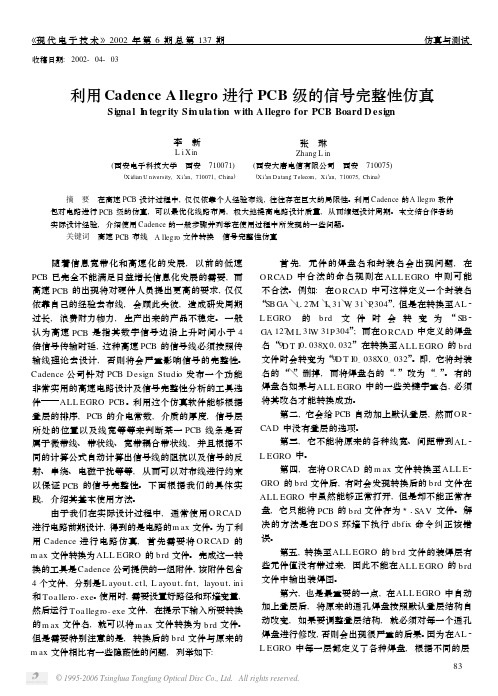
收稿日期:2002-04-03利用Cadence A llegro进行PCB级的信号完整性仿真Signa l I n tegr ity Si m ula tion w ith A llegro for PCB Board D esign李 新L i X in 张 琳Zhang L in(西安电子科技大学 西安 710071) (西安大唐电信有限公司 西安 710075)(X idian U niversity,X i′an,710071,Ch ina) (X i′an D atang Telecom,X i′an,710075,Ch ina)摘 要 在高速PCB设计过程中,仅仅依靠个人经验布线,往往存在巨大的局限性。
利用Cadence的A llegro软件包对电路进行PCB级的仿真,可以最优化线路布局,极大地提高电路设计质量,从而缩短设计周期。
本文结合作者的实际设计经验,介绍使用Cadence的一般步骤并列举在使用过程中所发现的一些问题。
关键词 高速PCB布线 A llegro文件转换 信号完整性仿真 随着信息宽带化和高速化的发展,以前的低速PCB已完全不能满足日益增长信息化发展的需要,而高速PCB的出现将对硬件人员提出更高的要求,仅仅依靠自己的经验去布线,会顾此失彼,造成研发周期过长,浪费财力物力,生产出来的产品不稳定。
一般认为高速PCB是指其数字信号边沿上升时间小于4倍信号传输时延,这种高速PCB的信号线必须按照传输线理论去设计,否则将会严重影响信号的完整性。
Cadence公司针对PCB D esign Studi o发布一个功能非常实用的高速电路设计及信号完整性分析的工具选件ALL EGRO PCB。
利用这个仿真软件能够根据叠层的排序,PCB的介电常数,介质的厚度,信号层所处的位置以及线宽等等来判断某一PCB线条是否属于微带线、带状线、宽带耦合带状线,并且根据不同的计算公式自动计算出信号线的阻抗以及信号的反射、串绕、电磁干扰等等,从而可以对布线进行约束以保证PCB的信号完整性。

电路板级的信号完整性问题和仿真分析摘要:今天随着电子技术的发展,电路板设计中的信号完整性问题已成为PCB设计者必须面对的问题。
信号完整性指的是什么?信号在电路中传输的质量。
由于电子产品向高速、微型化的发展,导致集成电路开关速度的加快,产生了信号完整性问题。
常见的问题有反弹、振铃、地弹和串扰等等。
这些问题将会对电路板设计产生怎样的影响?通过理论分析探讨,找到解决它们的一些途径。
传统的PCB设计是在样机中去测试问题,极大的降低了产品设计的效率。
使用EDA工具分析,可以将问题在计算机中进行暴露处理,降低问题的出现,提高产品的设计效率。
这里以Altium Designer 6.0工具为例,介绍分析解决部分信号完整性问题的方法。
关键词:信号完整性 Altium Designer 6.0 仿真分析[中图分类号] O59 [文献标识码] A [文章编号] 1000-7326(2012)04-0125-0320世纪初叶,科学家先后发明了真空二极管和三极管,它代表人类进入了电子技术时代。
随后半导体晶体管和集成电路的出现,将电子技术推向了一个新的时期。
特别是IC芯片的发展,使电子产品越来越趋向于小型化、高速化、数字化。
但同时却给电子设计带来一个新的问题:体积减小导致电路的布局布线密度变大,而同时信号的频率也在迅速提高,如何处理越来越快的信号。
这就是我们硬件设计中遇到的最核心问题:信号完整性。
为什么我们以前在学校学习和电子制作中没有遇到呢?那是因为在模拟电路中,采用的是单频或窄频带信号,我们关心的只是电路的信噪比,没有去考虑信号波形和波形畸变;而在数字电路中,电平跳变的信号上升时间比较长,一般为几个纳秒。
元件间的布线不会影响电路的信号,所以都没有去考虑信号完整性问题。
但是今天,随着GHz时代的到来,很多IC的开关速度都在皮秒级别,同时由于对低功耗的追求,芯片内核电压越来越低,电子系统所能容忍的噪声余量越来越小,那么电路设计中的信号完整性问题就突现出来了。
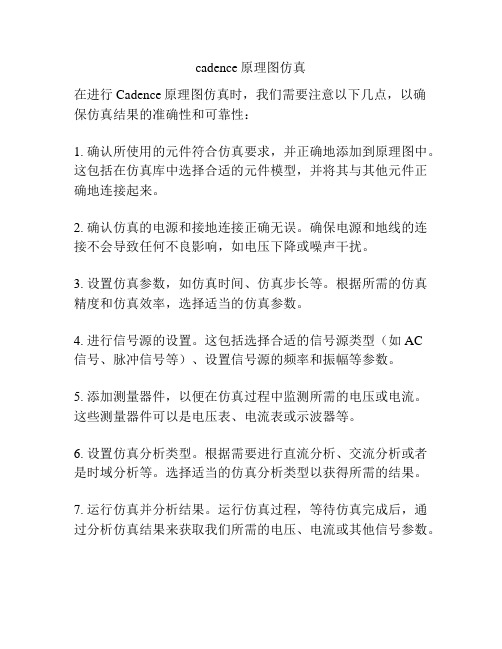
cadence原理图仿真
在进行Cadence原理图仿真时,我们需要注意以下几点,以确保仿真结果的准确性和可靠性:
1. 确认所使用的元件符合仿真要求,并正确地添加到原理图中。
这包括在仿真库中选择合适的元件模型,并将其与其他元件正确地连接起来。
2. 确认仿真的电源和接地连接正确无误。
确保电源和地线的连接不会导致任何不良影响,如电压下降或噪声干扰。
3. 设置仿真参数,如仿真时间、仿真步长等。
根据所需的仿真精度和仿真效率,选择适当的仿真参数。
4. 进行信号源的设置。
这包括选择合适的信号源类型(如AC
信号、脉冲信号等)、设置信号源的频率和振幅等参数。
5. 添加测量器件,以便在仿真过程中监测所需的电压或电流。
这些测量器件可以是电压表、电流表或示波器等。
6. 设置仿真分析类型。
根据需要进行直流分析、交流分析或者是时域分析等。
选择适当的仿真分析类型以获得所需的结果。
7. 运行仿真并分析结果。
运行仿真过程,等待仿真完成后,通过分析仿真结果来获取我们所需的电压、电流或其他信号参数。
通过遵循以上步骤,我们可以在Cadence中进行原理图仿真,并获取准确可靠的仿真结果,以验证电路设计的正确性和性能。


基于Cadence的电源完整性仿真步骤1、设置电路板的参数用PI模式打开要仿真的电路板,仿真其CPU_1.8V电源平面的完整性。
1.1调用设置向导在PI中选择“Analyze”—>“Power Integrity”出现提示对话框,点击“确定”后出现设置向导窗口。
1.2板框(Board Outline)点击“Next”进入设置向导里的“Board Outline”窗口PI需要一个板框来进行布局和电源平面提取。
如果板框不完整或不存在,则上图右上角会有信息提示。
1.3Stack-up设置点击“Next”进入设置向导里的“Stack-up”窗口。
PI需要叠层关系来计算电源对从而为平面建模。
如果叠层不存在或者不包含平面层,则屏幕右上角会有信息显示。
在这里可以调整叠层关系(Edit stack-up)或从另一个设计中导入(Import stack-up)。
屏幕右上角有相应的示意图,如图:当不勾选“Physical view”时,各层厚度平均显示;勾选后各层按比例显示。
1.4DC Net-Plane Association点击“Next”进入设置向导里的“DC Net-Plane Association”窗口,如图:PI 在估算去耦电容之前需要给每一个需要仿真的电源平面分配DC电压,在这里可以调整现有的电压分配。
同一层的分割平面会有不同的“shape”,因此每个“shape”都有一个不同的DC网络。
1.5DC Power Pair Setup点击“Next”进入设置向导里的“DC Power Pair Setup”窗口,如图:在进行PI 之前,电源和地平面必须成对。
一个地可以被多个平面共享,但一次只能分析一对平面。
在“Plane 1”栏中选择要分析的平面,在“Plane 2”栏中选择对应的平面,选中的平面对将在右边的叠层视图中高亮。
点击“Add”创建对应的平面对。
1.6选择去耦电容点击“Next”,如图:1.7选择电容模型点击“Next”,如图:选好所用的电容模型后,点击“Finish”完成对电路板参数的设置,弹出“Power Integrity Design&Analyze”窗口,如图:2、单节点仿真可以通过运行单节点仿真来验证选择的电容数量能否在频率范围内维持目标阻抗。
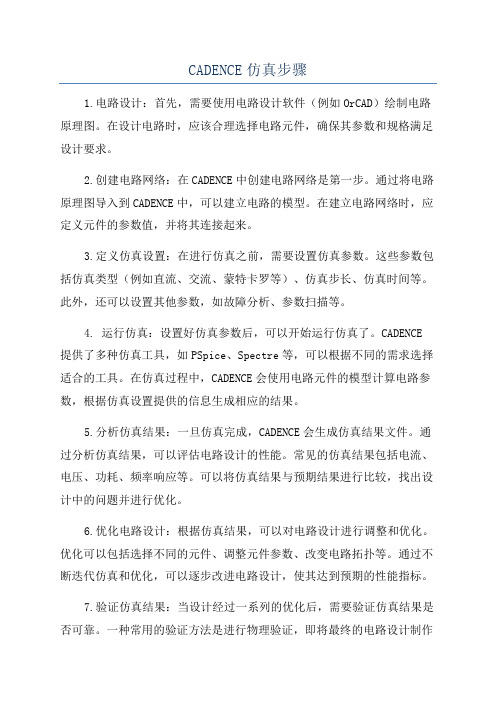
CADENCE仿真步骤1.电路设计:首先,需要使用电路设计软件(例如OrCAD)绘制电路原理图。
在设计电路时,应该合理选择电路元件,确保其参数和规格满足设计要求。
2.创建电路网络:在CADENCE中创建电路网络是第一步。
通过将电路原理图导入到CADENCE中,可以建立电路的模型。
在建立电路网络时,应定义元件的参数值,并将其连接起来。
3.定义仿真设置:在进行仿真之前,需要设置仿真参数。
这些参数包括仿真类型(例如直流、交流、蒙特卡罗等)、仿真步长、仿真时间等。
此外,还可以设置其他参数,如故障分析、参数扫描等。
4. 运行仿真:设置好仿真参数后,可以开始运行仿真了。
CADENCE 提供了多种仿真工具,如PSpice、Spectre等,可以根据不同的需求选择适合的工具。
在仿真过程中,CADENCE会使用电路元件的模型计算电路参数,根据仿真设置提供的信息生成相应的结果。
5.分析仿真结果:一旦仿真完成,CADENCE会生成仿真结果文件。
通过分析仿真结果,可以评估电路设计的性能。
常见的仿真结果包括电流、电压、功耗、频率响应等。
可以将仿真结果与预期结果进行比较,找出设计中的问题并进行优化。
6.优化电路设计:根据仿真结果,可以对电路设计进行调整和优化。
优化可以包括选择不同的元件、调整元件参数、改变电路拓扑等。
通过不断迭代仿真和优化,可以逐步改进电路设计,使其达到预期的性能指标。
7.验证仿真结果:当设计经过一系列的优化后,需要验证仿真结果是否可靠。
一种常用的验证方法是进行物理验证,即将最终的电路设计制作出来并测量其实际性能。
通过比较实际测量结果与仿真结果,可以验证仿真的准确性,并进行必要的修正。
8. 导出设计文件:一旦电路设计完成并验证通过,就可以将设计文件导出,准备进一步的生产制造。
将设计文件导出为标准的格式(如Gerber文件),可以将其发送给制造商进行生产。
总结:CADENCE仿真步骤包括电路设计、创建电路网络、定义仿真设置、运行仿真、分析仿真结果、优化电路设计、验证仿真结果和导出设计文件。

收稿日期利用Cade nce Al l e gro进行PCB级的信号完整性仿真Si gnal I nt e gri t y Si m ul ati on wi th Al l e g ro f or PCB Board D e s i g n李新¬É¸ÉÎ张琳ºÈÁÎǬÉÎ西安电子科技大学西安 西安大唐电信有限公司西安¸ÉÄÉÁεÎÉÖÅÒÓÉÔÙ ¸ÉcÁÎ £ÈÉÎÁ ¸ÉcÁΤÁÔÁÎÇ´ÅÌÅÃÏÍ ¸ÉcÁÎ £ÈÉÎÁ摘要在高速°£¢设计过程中 仅仅依靠个人经验布线 往往存在巨大的局限性"利用£ÁÄÅÎÃÅ的¡ÌÌÅÇÒÏ软件包对电路进行°£¢级的仿真 可以最优化线路布局 极大地提高电路设计质量 从而缩短设计周期"本文结合作者的实际设计经验 介绍使用£ÁÄÅÎÃÅ的一般步骤并列举在使用过程中所发现的一些问题"关键词高速°£¢布线¡ÌÌÅÇÒÏ文件转换信号完整性仿真随着信息宽带化和高速化的发展 以前的低速°£¢已完全不能满足日益增长信息化发展的需要 而高速°£¢的出现将对硬件人员提出更高的要求 仅仅依靠自己的经验去布线 会顾此失彼 造成研发周期过长 浪费财力物力 生产出来的产品不稳定"一般认为高速°£¢是指其数字信号边沿上升时间小于倍信号传输时延 这种高速°£¢的信号线必须按照传输线理论去设计 否则将会严重影响信号的完整性"£ÁÄÅÎÃÅ公司针对°£¢¤ÅÓÉÇγÔÕÄÉÏ发布一个功能非常实用的高速电路设计及信号完整性分析的工具选件¡¬¬¥§²¯°£¢"利用这个仿真软件能够根据叠层的排序 °£¢的介电常数 介质的厚度 信号层所处的位置以及线宽等等来判断某一°£¢线条是否属于微带线!带状线!宽带耦合带状线 并且根据不同的计算公式自动计算出信号线的阻抗以及信号的反射!串绕!电磁干扰等等 从而可以对布线进行约束以保证°£¢的信号完整性"下面根据我们的具体实践 介绍其基本使用方法"由于我们在实际设计过程中 通常使用¯²£¡¤进行电路前期设计 得到的是电路的ÍÁØ文件"为了利用£ÁÄÅÎÃÅ进行电路仿真 首先需要将¯²£¡¤的ÍÁØ文件转换为¡¬¬¥§²¯的ÂÒÄ文件"完成这一转换的工具是£ÁÄÅÎÃÅ公司提供的一组附件 该附件包含 个文件 分别是¬ÁÙÏÕÔ1ÃÔÌ ¬ÁÙÏÕÔ1ÆÎÔ ÌÁÙÏÕÔ1ÉÎÉ和´ÏÁÌÌÅÒÏ1ÅØÅ"使用时 需要设置好路径和环境变量 然后运行´ÏÁÌÌÅÇÒÏ1ÅØÅ文件 在提示下输入所要转换的ÍÁØ文件名 就可以将ÍÁØ文件转换为ÂÒÄ文件"但是需要特别注意的是 转换后的ÂÒÄ文件与原来的ÍÁØ文件相比有一些隐蔽性的问题 列举如下首先 元件的焊盘名和封装名会出现问题 在¯²£¡¤中合法的命名规则在¡¬¬¥§²¯中则可能不合法"例如 在¯²£¡¤中可这样定义一个封装名/³¢§¡ø 1 ø¬ ø· ø° 0 但是在转换至¡¬2¬¥§²¯的ÂÒÄ文件时会转变为/³¢2§¡ ¬ · ° 0 而在¯²£¡¤中定义的焊盘名/ ¤´© 1 ¸ 1 0在转换至¡¬¬¥§²¯的ÂÒÄ文件时会转变为/ ¤´© ¿ ¸ ¿ 0"即 它将封装名的/ø0删掉 而将焊盘名的/10改为/¿0"有的焊盘名如果与¡¬¬¥§²¯中的一些关键字重名 必须将其改名才能转换成功"第二 它会给°£¢自动加上默认叠层 然而¯²2£¡¤中没有叠层的选项"第三 它不能将原来的各种线宽!间距带到¡¬2¬¥§²¯中"第四 在将¯²£¡¤的ÍÁØ文件转换至¡¬¬¥2§²¯的ÂÒÄ文件后 有时会发现转换后的ÂÒÄ文件在¡¬¬¥§²¯中虽然能够正常打开 但是却不能正常存盘 它只能将°£¢的ÂÒÄ文件存为31³¡¶文件"解决的方法是在¤¯³环境下执行ÄÂÆÉØ命令纠正该错误"第五 转换至¡¬¬¥§²¯的ÂÒÄ文件的装焊层有些元件值没有带过来 因此不能在¡¬¬¥§²¯的ÂÒÄ文件中输出装焊图"第六 也是最重要的一点 在¡¬¬¥§²¯中自动加上叠层后 将原来的通孔焊盘按照默认叠层结构自动改变 如果要调整叠层结构 就必须对每一个通孔焊盘进行修改 否则会出现很严重的后果"因为在¡¬2¬¥§²¯中每一层都定义了各种焊盘 根据不同的层5现代电子技术6 年第 期总第 期仿真与测试进行选择 相比之下 ¯²£¡¤只在平面层上才定义热焊盘"在成功转到¡¬¬¥§²¯之后 还需要做些仿真前的准备"首先是根据器件的¤ÁÔÁÓÈÅÅÔ对器件的©¢©³进行检查 检查的内容包括¹察看©¢©³库是否有语法上的错误 这个可以在将©¢©³文件转换成ÄÍÌ文件报告时看出 或是在转换后的ÄÍÌ文件上 用¡¬¬¥§²¯的工具中的ÄÍÌÃÈÅÃË选项进行检查º管脚的输入!输出类型是否正确»¶©!¶´曲线是否有明显的非单调性!不连续性或其他明显的错误¼对所有的管脚模型是否都有ÁØ ÉÎ ´ÙÐÉ2ÃÁÌ值以及它们的关系是否正确 如果只有´ÙÐÉÃÁÌ值 那么仿真的时候只能用´ÙÐÉÃÁ̽所有的输出和双向管脚模型是否都有测试负载值 即£ÒÅÆ ²ÒÅÆ ¶ÒÅÆ和¶ÍÅÁÓ 如果是纯容性测试负载 可以没有²ÒÅƾ在标准测试负载情况下 ¶´的上升和下降的波形是否达到了¶ÍÅÁÓ的值¿©¢©³库的管脚是否与器件的¤ÁÔÁÓÈÅÅÔ管脚相一致"做完这些检查之后 就要对相应的器件指定各自的©¢©³库"而对离散器件 则要手工加上³°©£¥库"接着 需要指定¤£网线的电压值 这是为以后抽取模型时 不至于把¤£网线当成是信号网线"再下一步进行叠层编辑时 还需要同制板厂商联系 让他们给出满足需要的°£¢各层的介电常数!介质厚度!铜皮厚度以及叠层的顺序 上述参数要填在叠层表中"做完准备工作后 就可以抽取网线的拓扑结构进行信号完整性仿真了"仿真分为 种 一种是数据线仿真 一种是时钟线仿真 这都是在同步电路下进行的"仿真时 应该从器件的¤ÁÔÁÓÈÅÅÔ中查找以下的参数 ´ÃÏ1ÍÉÎ ´ÃÏ1ÍÁØ ´ÃÙÃÌÅ ´ÓÅÔÕÐ1ÍÉÎ ´ÈÏÌÄ1ÍÉÎ 从所提供的时钟的¤ÁÔÁÓÈÅÅÔ中查找´ÓËÅ×1ÃÌË ´ÊÉÔ 另外还需要估计°£¢的´ÓËÅ×1Ðà给出余量´ÍÁÒÇÉÎ"然后根据以下两个计算公式计算两个参数´ÓÅÔÔÌÅÄÅÌÁÙ1ÍÁØ和´Ó×ÉÔÃÈÄÅÌÁÙ1ÍÉÎ"这两个算式分别为´ÓÅÔÔÌÅÄÅÌÁÙ1ÍÁØ[´ÃÙÃÌÅ ´ÃÏ1ÍÁØ ´ÓÅÔÕÐ1ÍÉδÓËÅ×1ÃÌË ´ÓËÅ×1Ðà´ÊÉÔ ´ÁÄÊ ´Ó×ÉÔÃÈÄÅÌÁÙ1ÍÉÎ\´ÈÏÌÄ ´ÃÏ1ÍÉÎ ´ÓËÅ×1ÐôÓËÅ×1ÃÌË经过仔细分析 发现该公式确实已考虑得非常周全 把上升和下降沿的细微时间以及沿的细小抖动也包含在内 这可能也是£ÁÄÅÎÃÅ的°£¢软件中最核心最精华的部分"通过公式算出´ÓÅÔÔÌÅÄÅÌÁÙ1ÍÁØ ´Ó×ÉÔÃÈÄÅÌÁÙ1ÍÉÎ后 需要和根据拓扑结构仿真出来的´ÓÅÔÔÌÅÄÅÌÁÙ1ÍÁØ ´Ó×ÉÔÃÈÄÅÌÁÙ1ÍÉÎ值进行比较 以便用来调整参数"这些参数包括 布线长度 线阻抗 线速 增加减电阻!电容 节点的位置以及线的连接方式等"时钟线还需考虑它的单调性"参数调节是不能随心所欲的 不仅要找一定的规律 还要考虑到°£¢叠层的参数设置及一些现实所允许的值"这样才能找到适合实际°£¢的!比较理想的拓扑结构 否则如果在自动布线完成后才发现拓扑结构有问题 就需要来回进行修改"还要注意一点 就是所有以上参数都必须在最坏情况下找出它们的最大范围"所谓最坏情况是指 在仿真´ÓÅÔÔÌÅÄÅÌÁÙ1ÍÁØ数据时 必须是在ÓÌÏ×的环境下 而仿真´Ó×ÉÔÃÈÄÅÌÁÙ1ÍÉÎ数据时 必须在ÆÁÓÔ的环境下进行"在我们仿真的过程中 还发现有些器件的´ÃÏ1ÍÉÎ和´ÃÏ1ÍÁØ是在不同的测试条件下测试的 在仿真时还要改变ÄÍÌ库的测试环境值 才能测出更准确的值"调整好拓扑结构后 千万别忘了填写拓扑结构的限制表 限制表里头才是最终起作用的限制条件"接下来只要将填好限制后的拓扑结构加在同类网线上 然后转到³°¥£´²¡中进行自动布线"³°¥£´²¡会尽量根据限制自动布线 但是 最后在¡¬¬¥§²¯中做检查时 会发现有一些¤²£报告是因为没有按照限制完成布线 它会提示限制是多长 而实际只布了多长"这时 一种解决方法是删除所有线 改变器件位置 重新自动布线 再一种就需要改变拓扑结构 如果两种方法都失败了 就要考虑到换性能更好的器件"按照以上方法 一块高质量信号完整性的高速°£¢就已基本完成"通过使用£ÁÄÅÎÃÅ软件进行信号完整性的仿真 我们体会到该软件具有很强的实用性 对于硬件设计人员来说 是一种不可多得的设计工具 对高速°£¢来说尤为如此"当然 对于这样一个高智能仿真软件 使用起来也并不那么容易 如果对它的内部计算不甚了解 很有可能会因为一两个参数或选项的错误而导致仿真结果失败"希望本文能够起到一定的帮助作用"参考文献£ÁÄÅÎÃÅ£ÏÒÐ ¡ÌÌÅÇÒÏ°£¢¬ÁÙÏÕÔ³ÙÓÔÅÍ´ÒÁÉÎÉÎÇÁÕÎÁÌ£ÁÄÅÎÃÅ£ÏÒÐ ¡ÌÌÅÇÒÏÏÎÌÉÎÅÒÅÆÅÒÅÎÃÅÍÁÎÕÁÌÓ ²ÏÙ¬ÅÖÅÎÔÈÁÌ ³ÉÇÎÁÌ©ÎÔÅÇÒÉÔÙ¢ÏÁÒĤÅÓÉÇÎ ³ÉÍÕÌÁÔÉÏδÅÃÈÎÉÑÕÅÓ利用£ÁÄÅÎÃÅ¡ÌÌÅÇÒÏ进行°£¢级的信号完整性仿真收稿日期COR D I C算法在D SP算法硬件实现中的应用进展COR D I C Al gori t hm c s Appl i cati ons and D e v e l opm e nt s i n D SP H ardware R e al i zi ng李岩 ¬É¹ÁÎ汪海明·ÁÎǨÁÉÍÉÎÇ郭士德§ÕϳÈÉÄÅ赵建业ºÈÁϪÉÁÎÙÅ余道衡¹Õ¤ÁÏÈÅÎÇ北京大学电子学系声场与声信息处理国家重点实验室北京 北京大学遥感所北京 ¤ÅÐ1ÏÆ¥ÌÅÃÔÒÏÎÉÃÓ ®ÁÔ1¬ÁÂ1ÏÆÁÃÈÉÎÅ°ÅÒÃÅÐÔÉÏÎ °ÅËÉÎǵÎÉÖÅÒÓÉÔÙ ¢ÅÉÊÉÎÇ £ÈÉÎÁ´ÈÅ©ÎÓÔÉÔÕÔÅÏƲÅÍÏÔųÓÅÎÓÉÎÇÁÎħ©³ °ÅËÉÎǵÎÉÖÅÒÓÉÔÙ ¢ÅÉÊÉÎÇ £ÈÉÎÁ摘要£¯²¤©£算法被广泛应用于数字信号处理算法的硬件实现中"由于它将许多复杂的算术运算化成简单的加法和移位操作 因此它在许多¤³°算法的硬件实现中都有着极为重要的意义"有了它 许多难于实现而又极具应用价值的算术函数的硬件实现成为了可能"本文首先介绍了£¯²¤©£算法的理论概要 然后给出了£¯²¤©£算法在国内外的应用现状"最后 给出了作者自行设计的基于£¯²¤©£算法的可参数化的¦¦´模型"关键词数字信号处理£¯²¤©£算法硬件实现£¯²¤©£算法 ´ÈÅ£ÏÏÒÄÉÎÁÔŲÏÔÁÔÉÏÎÁ̤ÉÇÉ2ÔÁÌ£ÏÍÐÕÔÅÒ 是¶ÏÌÄÅÒ等人于 年在美国航空控制系统的设计中提出来的 它是一种用于计算一些常用的基本运算函数和算术操作的循环迭代算法 其基本思想是用一系列与运算基数相关的角度的不断偏摆从而逼近所需旋转的角度» ½"从广义上讲它是一个数值性计算逼近的方法 由于这些固定的角度与计算基数有关 运算只有移位和加减"可用该算法来计算的函数包括乘!除!平方根!正弦!余弦!反正切!向量旋转 即复数乘法 以及指数运算等" 年 ª1³1·ÁÌÔÈÅÒ提出了统一的£¯²¤©£算法形式» ½ 把圆周旋转!双曲旋转和直线旋转统一到同一个£¯²¤©£迭代方程里 为同一硬件实现多功能提供了前提"随着¶¬³©技术的不断发展 £¯²¤©£算法越来越受到研究与应用人员的重视 更加展示出广泛的应用发展前景"在传统的硬件算法设计中 乘!除等基本数学函数运算是一种既耗时又占用面积大的运算 甚至有时是难以实现的 £¯²¤©£算法正是为解决这种问题而产生的"它从算法本身入手 将其分解成为一些简单的且在硬件中容易实现的基本算法 如加法!移位等 因此使得这些算法在硬件上可以得到较好的实现"又由于该算法是一种规则化的算法 它满足了硬件对算法的模块化!规则化的要求 因此£¯²¤©£算法可以充分发挥硬件的优势 利用硬件的资源 从而实现硬件与算法相结合的一种优化方案"正是由于上述原因 £¯²¤©£算法的原始思想一经提出 就受到了人们的普遍关注 年来人们不断地对其进行探索研究 并提出了各种改进算法和优化方案以适应各种不同的需求» * ½"我们觉得有必要介绍并讨论这一算法 使国内注意到£¯²¤©£算法的这一新的发展动向"1COR D I C算法理论概要下面简要介绍一下£¯²¤©£算法理论"设输入为xÉÎyÉÎ zÉÎ 参数为m 则£¯²¤©£算法如式 所示x i x i m D i A i y iy i y i m D i A i x iz i z i D i H i式 中当m 时 HiÔÁÎÈ A i当m 时 HiA i当m 时 H i ÔÁÎ A i "Abs t ract·ÉÔÈÔÈÅÉÎÃÒÅÁÓÅÄÄÅÍÁÎÄÏÆÈÉÇÈÄÅÎÓÉÔÙ ÈÉÇÈÓÐÅÅÄÂÏÁÒÄÄÅÓÉÇÎÓ ÓÉÇÎÁÌÉÎÔÅÇÒÉÔÙÓÉÍÕÌÁÔÉÏÎÉÓÂÅÃÏÍÉÎÇÍÏÒÅÉÍÐÏÒÔÁÎÔ1£ÁÄÅÎÃÅ¡ÌÌÅÇÒÏÉÓÊÕÓÔÔÈÅÔÏÏÌÔÈÁÔÃÁÎÍÅÅÔÔÈÅÎÅÅÄ1©ÔÄÅÌÉÖÅÒÓÁÎÅÃÏÎÏÍÉÃÆÒÏÎÔÔÏÂÁÃËÁÄÖÁÎÃÅÄÅÎÖÉÒÏÎÍÅÎÔÆÏÒÔÈÅÐÈÙÓÉÃÁÌÄÅÓÉÇÎÏÆÃÏÍÐÌÅØÍÕÌÔÉ ÌÁÙÅÒ°£¢ÄÅÓÉÇÎÓ1´ÈÉÓÐÁÐÅÒÍÁÉÎÌÙÉÎÔÒÏÄÕÃÅÓÈÏ×ÔÏÕÓÉÎÇÔÈÉÓÔÏÏÌÓ1 K e y wordsÈÉÇÈÓÐÅÅÄ°£¢ ¡ÌÌÅÇÒÏÆÉÌÅÃÈÁÎÇÅ ÓÉÇÎÁÌÉÎÔÅÇÒÉÔÙÓÉÍÕÌÁÔÉÏÎ作者简介李新男 西安电子科技大学研究生 研究方向 计算机系统结构"5现代电子技术6 年第 期总第 期仿真与测试。
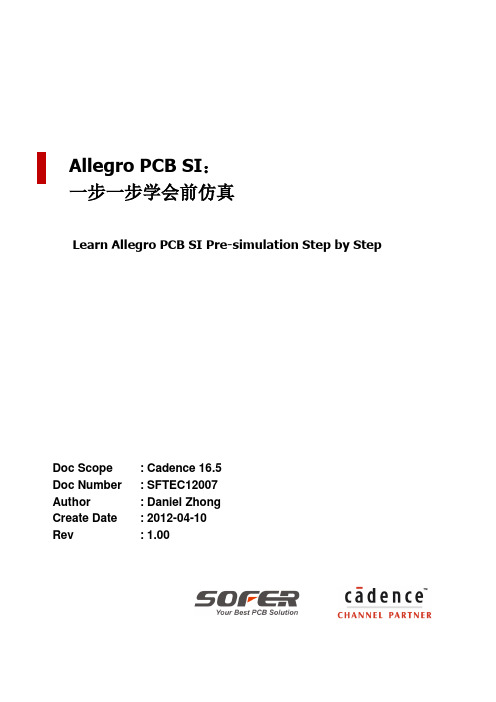
Allegro PCB SI:一步一步学会前仿真Learn Allegro PCB SI Pre-simulation Step by StepDoc Scope : Cadence 16.5Doc Number : SFTEC12007Author : Daniel ZhongCreate Date : 2012-04-10Rev : 1.00目录1Cadence Allegro PCB SI简介 (7)1.1高速PCB设计流程 (7)2Allegro PCB SI的前仿真 (8)2.1准备仿真模型和其他需求 (8)2.1.1获取所使用元器件的仿真模型 (9)2.1.2获取所使用连接器的仿真模型 (10)2.1.3获取所使用元器件和连接器的器件手册和用户指南等相关资料 (10)2.1.4获取所需的规范文档 (10)2.1.5了解相关电路和接口工作原理 (10)2.1.6提取与信号完整性相关的要求 (10)2.1.7预先创建拓扑样本 (11)2.1.8预先创建相对于不同阈值电压的眼图模板 (11)2.1.9预先创建自定义测量 (12)2.2仿真前的规划 (12)2.3关键器件预布局 (13)2.4模型加载和仿真配置 (13)2.4.1模型的转化 (14)2.4.2使用SI Design Setup配置 (15)2.4.3选择需要配置的信号线 (16)2.4.4设置仿真库 (18)2.4.5设置电源和地网络 (20)2.4.6设置叠层 (24)2.4.7设置元器件类别 (27)2.4.8为元器件分配和创建模型 (28)2.4.9设置差分对 (37)2.4.10设置仿真参数 (42)2.4.11SI Design Audit相关 (50)2.4.12提取拓扑 (52)2.4.13在SigXP中设置仿真库和仿真参数 (54)2.4.14在SigXP中绘制拓扑 (58)2.5方案空间分析 (68)2.5.1输出驱动力扫描分析 (71)2.5.2Stub长度扫描分析 (73)2.5.3线宽线间距扫描分析 (74)2.6方案到约束规则的转化 (76)2.6.1传输线延迟规则的设置 (77)2.6.2拓扑结构等传输线特性规则的设置 (80)2.6.3传输线耦合规则的设置 (80)2.6.4拓扑规则在约束管理器中的应用 (81)3Allegro PCB SI的后仿真 (84)表格表格 1:Routed Interconnect Models参数 (45)表格 2:Simulation栏眉仿真参数 (47)表格 3:IO Cell Stimulus Edit窗口中的选项 (68)图图 1:传统的PCB设计流程图 (7)图 2:Allegro PCB SI高速PCB设计流程图 (8)图 3:眼图模式下的眼图模板 (11)图 4:地址、命令和控制信号传输线拓扑 (12)图 5:RDIMM的布局示意图 (13)图 6:Model Integrity界面 (14)图 7:使用Model Integrity将IBIS文件转换至DML格式 (15)图 8:Cadence Product Choices产品选择器窗口 (16)图 9:Allegro PCB SI GXL界面 (17)图 10:Setup Category Selection窗口 (17)图 11:Setup Xnet Selection窗口 (17)图 12:Allegro PCB SI GXL关于网络设置的提醒框 (18)图 13:Setup Library Search Directories窗口 (19)图 14:Setup Library File Extensions窗口 (19)图 15:Setup Working Libraries窗口 (19)图 16:Setup Power and Ground Nets窗口 (20)图 17:Allegro PCB SI GXL电压赋值窗口 (21)图 18:选择“Edit Voltage On Any Net In Design” (21)图 19:Identify DC Nets窗口。
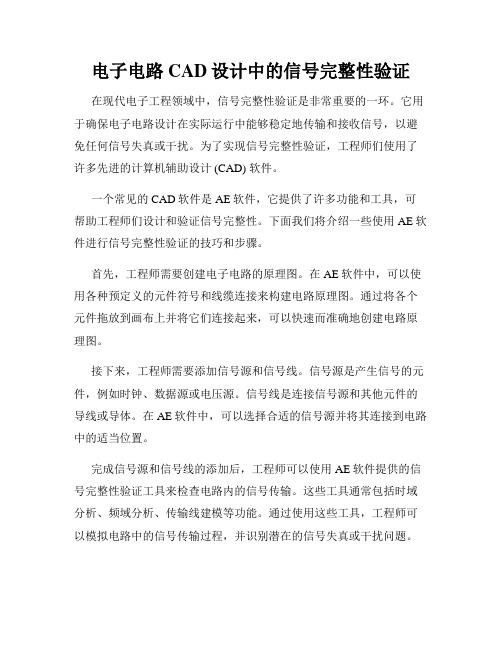
电子电路CAD设计中的信号完整性验证在现代电子工程领域中,信号完整性验证是非常重要的一环。
它用于确保电子电路设计在实际运行中能够稳定地传输和接收信号,以避免任何信号失真或干扰。
为了实现信号完整性验证,工程师们使用了许多先进的计算机辅助设计 (CAD) 软件。
一个常见的CAD软件是AE软件,它提供了许多功能和工具,可帮助工程师们设计和验证信号完整性。
下面我们将介绍一些使用AE软件进行信号完整性验证的技巧和步骤。
首先,工程师需要创建电子电路的原理图。
在AE软件中,可以使用各种预定义的元件符号和线缆连接来构建电路原理图。
通过将各个元件拖放到画布上并将它们连接起来,可以快速而准确地创建电路原理图。
接下来,工程师需要添加信号源和信号线。
信号源是产生信号的元件,例如时钟、数据源或电压源。
信号线是连接信号源和其他元件的导线或导体。
在AE软件中,可以选择合适的信号源并将其连接到电路中的适当位置。
完成信号源和信号线的添加后,工程师可以使用AE软件提供的信号完整性验证工具来检查电路内的信号传输。
这些工具通常包括时域分析、频域分析、传输线建模等功能。
通过使用这些工具,工程师可以模拟电路中的信号传输过程,并识别潜在的信号失真或干扰问题。
在进行信号完整性验证时,工程师通常会关注一些关键指标,如上升时间、下降时间、峰值电压、噪声电平等。
通过分析这些指标,工程师可以判断电路中是否存在信号传输方面的问题,并进行相应的优化和修正。
为了更好地进行信号完整性验证,工程师还可以使用AE软件提供的仿真功能。
通过进行仿真,工程师可以在计算机上模拟电路工作的情况,并观察信号的传输和接收过程。
这可以大大减少工程师在实际电路上进行试验和调整的时间和成本。
除了信号完整性验证工具和仿真功能,AE软件还提供了许多其他有用的功能,如电路优化、电路布局、特性提取等。
这些功能可以帮助工程师更好地设计和验证电子电路。
总的来说,信号完整性验证在电子电路CAD设计中扮演着重要的角色。

目录1.仿真前的准备工作 (2)1.1找到需要仿真的芯片的IBIS模型 (2)1.2模型转换(IBIS→DML) (2)1.3添加模型到Cadence的模型库中 (5)2. 对电路板进行设置(Setup Advisor) (7)2.1准备好要仿真的电路板 (7)2.2调用参数设置向导 (7)2.3叠层设置 (8)2.4设置DC电压值 (9)2.5器件设置(Device Setup) (10)2.6 SI模型分配 (12)2.7 SI检查(SI Audit) (16)2.8完成参数设置 (18)3.进行信号完整性仿真(反射) (19)3.1开始仿真 (19)3.2选择所要仿真的网络 (19)3.3提取网络的拓扑结构 (20)3.4给驱动端U8添加激励信号 (21)3.5设置激励信号的参数 (22)3.6执行反射仿真 (22)3.7仿真结果 (22)1.仿真前的准备工作1.1找到需要仿真的芯片的IBIS模型一般可以从芯片制造商网站上找到,如果没有,可能要通过其它途径获得如从SPICE模型中提取。
1.2模型转换 (IBIS→DML)将IBIS模型转换为DML模型,运用Cadence的Model Integrity工具将IBIS模型转化为Cadence能识别的DML模型,并验证仿真模型。
(1)单击“开始”按钮→“所有程序”→“Allegro SPB 15.5”→“Model Integrity”,如图1-1所示:图1-1 Model Integrity工具窗口(2)选择“File”→“Open”,打开一个IBIS模型如图1-2所示:图1-2 打开一个IBIS模型(3)在“Physical View”栏中,单击IBIS文件“sn74avca16245”→选择菜单栏里的“Options”→“Translation Options Editor”→弹出“Translation Options”窗口,如图1-3所示:图1-3 Translation Options窗口(4)默认选择“Make model names unique”,这个设置为每个IOCell模型名附加IBIS文件名。
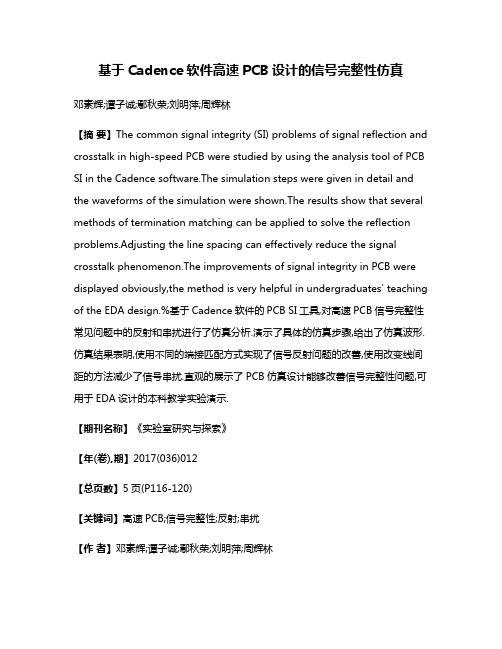
基于Cadence软件高速PCB设计的信号完整性仿真邓素辉;谭子诚;鄢秋荣;刘明萍;周辉林【摘要】The common signal integrity (SI) problems of signal reflection and crosstalk in high-speed PCB were studied by using the analysis tool of PCB SI in the Cadence software.The simulation steps were given in detail and the waveforms of the simulation were shown.The results show that several methods of termination matching can be applied to solve the reflection problems.Adjusting the line spacing can effectively reduce the signal crosstalk phenomenon.The improvements of signal integrity in PCB were displayed obviously,the method is very helpful in undergraduates' teaching of the EDA design.%基于Cadence软件的PCB SI工具,对高速PCB信号完整性常见问题中的反射和串扰进行了仿真分析.演示了具体的仿真步骤,给出了仿真波形.仿真结果表明,使用不同的端接匹配方式实现了信号反射问题的改善,使用改变线间距的方法减少了信号串扰.直观的展示了PCB仿真设计能够改善信号完整性问题,可用于EDA设计的本科教学实验演示.【期刊名称】《实验室研究与探索》【年(卷),期】2017(036)012【总页数】5页(P116-120)【关键词】高速PCB;信号完整性;反射;串扰【作者】邓素辉;谭子诚;鄢秋荣;刘明萍;周辉林【作者单位】南昌大学信息工程学院,南昌330031;南昌大学信息工程学院,南昌330031;南昌大学信息工程学院,南昌330031;南昌大学信息工程学院,南昌330031;南昌大学信息工程学院,南昌330031【正文语种】中文【中图分类】TN410 引言随着电子产品朝着高速率、高密度、小体积的方向发展,电子系统设计领域已经进入GHz及以上的设计领域。

用Cad ence进行信号完整性(SI)仿真流程第一章在Allegro 中准备好进行SI 仿真的PCB 板图1)在Cadence 中进行SI 分析可以通过几种方式得到结果:Allegro 的PCB 画板界面,通过处理可以直接得到结果,或者直接以*.brd 存盘。
使用SpecctreQuest 打开*.brd,进行必要设置,通过处理直接得到结果。
这实际与上述方式类似,只不过是两个独立的模块,真正的仿真软件是下面的SigXplore 程序。
直接打开SigXplore 建立拓扑进行仿真。
2)从PowerPCB 转换到Allegro 格式在PowerPCb 中对已经完成的PCB 板,作如下操作:在文件菜单,选择Export 操作,出现File Export 窗口,选择ASCII 格式*.asc 文件格式,并指定文件名称和路径(图1.1)。
图1.1 在PowerPCB 中输出通用ASC 格式文件图1.2 PowerPCB 导出格式设置窗口点击图1.1 的保存按钮后出现图1.2 ASCII 输出定制窗口,在该窗口中,点击“Select All”项、在Expand Attributes 中选中Parts 和Nets 两项,尤其注意在Format 窗口只能选择PowerPCB V3.0 以下版本格式,否则Allegro 不能正确导入。
3)在Allegro 中导入*.ascPCB 板图在文件菜单,选择Import 操作,出现一个下拉菜单,在下拉菜单中选择PADS 项,出现PADS IN 设置窗口(图1.3),在该窗口中需要设置3 个必要参数:图1.3 转换阿三次文件参数设置窗口i. 在的一栏那填入源asc 文件的目录ii. 在第二栏指定转换必须的pads_in.ini 文件所在目录(也可将此文件拷入工作目录中,此例)iii. 指定转换后的文件存放目录然后运行“Run”,将在指定的目录中生成转换成功的.brd 文件。

CADENCE仿真流程第一章进行SI仿真的PCB板图的准备仿真前的准备工作主要包括以下几点:1、仿真板的准备●原理图设计;●PCB封装设计;●PCB板外型边框(Outline)设计,PCB板禁止布线区划分(Keepouts);●输出网表(如果是用CADENCE的Concept HDL设计的原理图,可将网表直接Expot 到BRD文件中;如果是用PowerPCB设计的板图,转换到allegro中的板图,其操作见附录一的说明);●器件预布局(Placement):将其中的关键器件进行合理的预布局,主要涉及相对距离、抗干扰、散热、高频电路与低频电路、数字电路与模拟电路等方面;●PCB板布线分区(Rooms):主要用来区分高频电路与低频电路、数字电路与模拟电路以及相对独立的电路。
元器件的布局以及电源和地线的处理将直接影响到电路性能和电磁兼容性能;2、器件模型的准备●收集器件的IBIS模型(网上下载、向代理申请、修改同类型器件的IBIS模型等)●收集器件的关键参数,如T co、Tsetup、Tholdup等及系统有关的时间参数T clock、Tskew、Tjitter●对IBIS模型进行整理、检查、纠错和验证。
3、确定需要仿真的电路部分,一般包括频率较高,负载较多,拓扑结构比较复杂(点到多点、多点到多点),时钟电路等关键信号线第二章IBIS模型的转化和加载CADENCE中的信号完整性仿真是建立在IBIS模型的基础上的,但又不是直接应用IBIS 模型,CADECE的软件自带一个将IBIS模型转换为自己可用的DML(Device Model Library)模型的功能模块,本章主要就IBIS模型的转换及加载进行讲解。
1、IBIS模型到DML模型的转换在Allegro窗口中选择Analyse\SI/EMI SIM\Library,打开“signal analyze library browser”窗口,在该窗口的右下方点击“Translate →”按钮,在出现的下拉菜单中选择“ibis2signois”项,出现“Select IBIS Source File”窗口(图1),选择想要进行转换的源IBIS文件,按下“打开”按钮,出现转换后文件名及路径设置窗口(缺省设置为和源IBIS文件同名并同路径放置,但此处文件名后缀为dml),设置后按下“保存”按钮,出现保存确定窗口(图2),点击OK按钮即可,随后会出现一个“messages”窗口,该窗口中的报告文件说明在模型转换过程中出现的问题,对其中的“warning”可不用在意,但如果出现“error”则必须进行修改后重新进行模型格式转化直到没有“error”出现为止,此时转换得到的dml文件才是有效的。
IntroductionConsider the proverb, “It takes a village to raise a child.” Similarly, multiple design team members participate in assuring PCB power integrity (PI) as a design moves from the early concept phase to becoming a mature product. On the front end, there’s the electrical design engineer who is responsible for the schematic. On the back end, the layout designer handles physical implemen-tation. Typically, a PI analysis expert is responsible for overall PCB PI and steps in early on to guide the contributions of others. How quickly a team can assure PCB PI relates to the effectiveness of that team. In this paper, we will take a look at currently popular analysis approaches to PCB PI. We will also introduce a team-based approach to PCB PI that yieldsadvantages in resource utilization and analysis results.Common Power Integrity Analysis MethodsThere are two distinct facets of PCB PI – DC and AC. DC PI guarantees thatadequate DC voltage is delivered to all active devices mounted on a PCB (oftenusing IR drop analysis). This helps to assure that constraints are met for currentdensity in planar metals and total current of vias and also that temperatureconstraints are met for metals and substrate materials. AC PI concerns thedelivery of AC current to mounted devices to support their switching activitywhile meeting constraints for transient noise voltage levels within the powerdelivery network (PDN). The PDN noise margin (variation from nominalvoltage) is a sum of both DC IR drop and AC noise.DC PI is governed by resistance of the metals and the current pulled from thePDN by each mounted device. Engineers have, for many years, applied resistivenetwork models for approximate DC PI analysis. Now that computer speedsare faster and larger addressable memory is available, the industry is seeingmuch more application of layout-driven detailed numerical analysis techniquesfor DC PI. Approximation occurs less, accuracy is higher, and automation ofHow a Team-Based Approach to PCB Power Integrity Analysis Yields Better ResultsBy Brad Brim, Sr. Staff Product Engineer, Cadence Design SystemsAssuring power integrity of a PCB requires the contributions of multiple design team members. Traditionally, such an effort has involved a time-consuming process for a back-end-focused expert at the front end of a design. This paper examines a collaborative team-based approach that makes more efficient use of resources and provides more impact at critical points in the design process.ContentsIntroduction (1)Common Power IntegrityAnalysis Methods (1)Applying a Team-Based Approachto Power Integrity Analysis (3)Summary (6)For Further Information (7)whole-design analysis and postprocessing results are commonly available commercially. In fact, DC PI analysis for PCB designs has become a “signoff” requirement for many OEMs. See Figure 1 (left) for typical results for current density.Since metal conductivity is temperature-dependent, DC IR drop is a nonlinear analysis. IR drop results can vary by more than 20% when temperature effects are considered, according to case studies for high-power designs. There is, however, a way to accurately characterize PCB IR drop while assuring that the PDN noise margin isn’twasted. Using a DC analysis tool that provides capabilities such as electrical/thermal co-simulation, perform a linear electrical analysis at ambient temperature; take the resulting power loss and apply it to perform a linear thermal analysis. Then, perform another linear electrical analysis with consideration of the localized temperature-dependent conductivity. This process converges in just a few iterations to yield a desired result. See Figure 1 for an illustration of this solution, as implemented in the Cadence ® Sigrity ™ PowerDC ™DC analysis tool.TemperatureLoss DensityPlane Current Surface TemperatureElectrical Analysis Thermal AnalysisFigure 1: Current density (left) and temperature distribution (right) for a PCB design due to DC powerdelivery as two linear solutions are iteratively linked to address nonlinear electro-thermal analysis.AC PI is governed by voltage regulator modules, loop inductances, decoupling capacitors (decaps), and plane capacitance. AC PI effects tend to be global in nature due to plane resonances, plane-to-plane coupling, and shared reference planes. As such, this calls for full-board analysis, as well as more resource-intensive analysis algorithms. A hybrid of circuit theory and electromagnetic (EM) analyses is the most commonly applied AC PI analysis for PCBs. This type of analysis is available in the frequency domain to extract S-parameters, using a tool such as Cadence Sigrity PowerSI ™ frequency-domain electrical analysis solution. It’s also available in the time domain to directly generate transient waveforms, using a tool such as Cadence Sigrity Speed2000™ time-domain analysis solution. With the proper tools, an engineer can, in tens of minutes, accurately characterize the PDNbehavior of even the largest and most complex PCBs from DC to multi-gigahertz using single- to low double-digit gigabytes of memory.Transient PI analysis may seem attractive because it directly yields noise waveforms; however, in reality, it is less commonly applied than frequency-domain impedance analysis. “Target impedance” profiles are applied as PIconstraints. Lower impedance corresponds to lower transient noise. Without direct vendor specification, reasonable target impedance may be estimated based on device specifications for voltage ripple and AC switching current. See Figure 2 for a comparison of frequency-domain and time-domain results. In this comparison, the Cadence Sigrity OptimizePI ™ tool was used to significantly reduce an impedance peak near 800MHz by applying an alternate set of decaps to mount for a DIMM module. This solution reduced peak-to-peak PDN noise for the optimized design by 12% and the component and manufacturing cost of the decap implementation by 21%.Figure 2: Impedance profile and transient PDN noise of a DIMM before and after thedecap implementation was optimized.Applying a Team-Based Approach to Power Integrity AnalysisTraditionally, PI experts have performed pre-layout decap selections and initial IR drop analyses. This is a substantial time investment at the front end of a design for a back-end-focused expert. By applying a more collaborative approach, a design team can make better use of its resources and expertise, and generate more impactful results.A team could set up simple analyses that yield actionable results and that could be performed by other members of the PI team. This PCB PI team would ideally consist of three key members: design engineer, layout designer, and PI analysis expert, as shown in Figure 3.Design Engineer•Can start with either BOM or schematic•Apply Power Feasibility Editor for DeCap selection and PIconstraint definitionLayout Designer•Can start as early asfloorplanning stage•First order analysis directlyon layout•Analyze, edit, re-analyze•DeCap placement guidanceand DRCPI Analysis Expert•Can start at any stage•Leverages setup and datafrom rest of team•Signoff capable detailedanalysisFigure 3: Roles and responsibilities of the PCB PI design team.There is now a tool available on the market that supports team-based PCB PI analysis. Cadence Allegro® SigrityPI is the industry’s first front-to-back, constraint-based PI approach for PCB and IC package designs. This tool differs from other solutions in the way that it accesses existing analysis algorithms and how the analysis resultsare applied. In addition, the tool also provides PI-focused infrastructure support of non-analysis tasks. As a result, design engineers and layout designers can contribute earlier and more effectively to PCB PI. The DC and AC PI analysis capabilities described in the previous section are available in the associated Power Integrity Signoff and Optimization Option.PCB design engineers are responsible for front-end tasks. They must generate an initial Bill of Materials (BOM)to set in motion cost feasibility studies and assure electrical design intent by generating circuit schematics. They typically work independently of DC PI concerns. However, to support AC PI, design engineers must add decaps and include them in the BOM and the schematic. Some device vendors provide datasheet guidance for decap selection (type and/or quantity), but many do not. Even with datasheet guidance, it is tedious for design engineers to assemble and interpret the specifications for each device, instantiate all the unique components, assure they appear logically in the schematic, etc. No mechanism has existed for physical placement guidance to be communicated for back-end application.With constraint-based design methods, engineers gain a uniform interface for design-intent information and for automating a broad class of tasks across front-to-back flows. PI [electrical] constraint sets (PI Csets) have been added to save all component-level PI information. Design engineers may apply PI Csets to quickly and completely define PI design intent for all mounted components. PI Csets also automate instantiation of components and inclusion in the BOM.Refer to Figure 4 for an example of a PI Cset in Allegro Sigrity PI. PI Csets contain information for each power rail, including decap component names, quantity of each component, package type, and physical placement guidance.Figure 4: PI constraint set contents viewed from the constraint manager.PI Cset creation is automated by the tool’s Power Feasibility Editor, which provides a mechanism to enter datasheet decap selection and physical placement guidance. Figure 5 shows a view of the tool’s Power Feasibility Editor. In addition to placement guidance, a PI Cset communicates to the layout designer component and power rail associ-ation for decaps, helping the designer perform more reliable placement.Figure 5: Single-point analysis results in the Power Feasibility Editor.The Power Feasibility Editor also provides access to approximate and detailed pre-layout analysis for selectionand placement of decaps. High-level specifications are made to generate target impedance profiles when device vendors do not provide them. An approximate PI analysis called “single-point” is provided for interactive decap selection. For more detailed pre-layout, the tool provides access to the data in the Cadence Sigrity OptimizePI tool. The engineer simply clicks a button within the Power Feasibility Editor to generate PI Csets.Figure 6: Split-screen view of layout (left) and IR drop analysis results (right).Unlike design engineers, layout designers are concerned with DC PI issues. Layout designers control metal shapes and vias and these, in turn, control PI behaviors for DC IR drop and current flow. Layout designers can intuitively understand and act upon analysis results for these DC PI effects. The Allegro Sigrity PI tool provides access within the layout environment to the setup and results display for DC IR drop and current constraint analyses. DC analysis is fast, though not conducted in real time in order to enable dynamic updating of analysis results as layout updates are made.The tool provides a split-screen view, as shown in Figure 6, to support a fixed view of analysis results as layout designers dynamically make updates to address IR drop or current constraint issues. The two views are synchro-nized for operations that affect the display, such as layer changes, zoom, and pan. Layout designers can apply this split-screen view of DC analysis results as they craft an initial layout, before the PI analysis expert gets involved.As a more effective method to communicate where PI issues exist in the design, the split-screen view can also be applied with detailed analysis results performed separately by PI analysis experts. In fact, to more quickly verify improved PI performance, the layout designer can launch the same detailed analysis performed by the PI analyst. Layout designers strongly influence AC PI success with their placement of decaps. Decaps placed close to a device generally benefit PI, but restrict routing channels due to decap mounting vias. Decaps placed too far from a device will be ineffective at providing switching current to the device and will negatively affect PI. Present design methods do not typically provide decap placement guidance, including information as simple as which device is associated with a decap. By conveying design intent, previously described PI Csets enable more effective placement of decaps by layout designers. The associated device and power rail and placement guidance are all specified in the PI Cset.A decap placement mode is implemented to support layout designers, as shown in Figure 7. Simply select a mounted component and a power rail, and then cycle through a point-and-click placement process. The selected device is highlighted and three optional visual placement guidance displays are available: device to decap distance for top layer, device to decap distance for bottom layer, and decap effective radius. The first two are defined in the PI Cset and are conceptually familiar. The decap effective radius is the maximum distance at which the decap will be maximally effective. It is a function of the stack-up and decap mounting parasitics as well as the decap value and its intrinsic parasitics. It is dynamically computed as the cursor moves due to local availability of metal shapes on the associated power and ground layers.Decap Placement GuidanceTop-sideSetbackDistance*DecapEffectiveRadiusBottom-sideSetbackDistanceFigure 7: Layout view during decap placement for device U0501 with top (yellow) and bottom (blue)setback distances and decap effective radius (white circle) displayedTo ease the setup for detailed PI analysis, design intent and analysis setup information specified by design engineers and layout designers is available to PI analysis. PI Csets serve as a convenient mechanism to communicate updated placement guidance or requirements for updates on decap selection (either type or quantity) for a specific device instance or all devices to which a PI Cset is applied. Changes to PI Csets also convey information back to the design engineer and enable automated update of the schematic and BOM.SummaryWhile current PCB PI analysis tools are continuing to serve the design community well, they are even more effective when combined with a front-to-back, constraint-based approach. Under this type of methodology, each design team member can more efficiently accomplish his or her individual tasks and communicate design intent infor-mation to colleagues for increased efficiency of the overall PCB design flow. This approach provides access toactionable analysis results where they are most impactful. It also leverages earlier defined analysis setup infor-mation for the PI expert, and eases communication of design changes from his or her back-end role to front-end colleagues.For Further InformationTo learn more about Cadence Allegro Sigrity PI solution, visit: /products/sigrity/Pages/ solution.aspxCadence Design Systems enables global electronic design innovation and plays an essential role in thecreation of today’s electronics. Customers use Cadence software, hardware, IP, and expertise to designand verify today’s mobile, cloud and connectivity applications. © 2014 Cadence Design Systems, Inc. All rights reserved. Cadence, the Cadence logo, and Allegro are registered trademarks and OptimizePI,PowerDC, PowerSI, Sigrity, and Speed2000 are trademarks of Cadence Design Systems, Inc. All others are properties of their respective holders.。